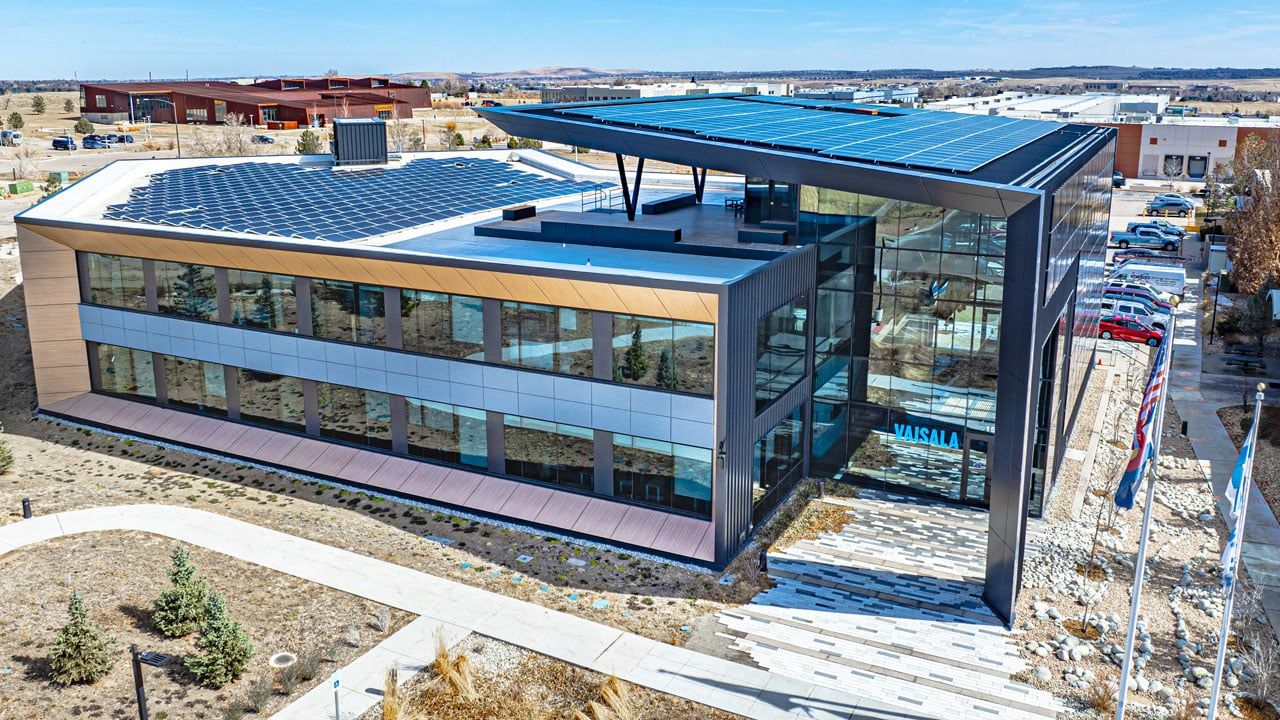Below net-zero in lap of luxury
One property under construction in Boulder County blends the best modern technology has to offer, a vision for luxury living without a carbon footprint, and a lovely contemporary aesthetic into what could become the most energy-efficient home in Boulder County.
The 7,700-square-foot home when completed should produce more energy that it uses and earn a Home Energy Rating System score, or HERS score, of negative 29.
SPONSORED CONTENT
Commercial Solar is a big investment, but not an overwhelming one
Solar offers a significant economic benefit for commercial property owners while also positively impacting the environment and offering a path to compliance for new municipal requirements like Energize Denver. A local, experienced solar installer will help you navigate the complexities of commercial solar to achieve financial success for your project.
“That’s the lowest ever permitted in Boulder County,” said Kevin O’Donnell, president of Avon-based Beck Building Co. and part of the team working on the home at 6712 Jay Road.
The HERS system is a nationally recognized standard used to evaluate a home’s energy efficiency. The standard home built today earns a HERS rating of 100, according to the nonprofit Residential Energy Services Network. On a HERS scale, a home with a score of 70 would be 30 percent more efficient that a standard home. With a rating of negative 29, the Jay Road home would produce 29 percent more energy than it uses.
The project began in 2012 with extensive site work remediating expansive soils and a high water table, but energy efficiency trumped all from the start.
“On this project, quite simply, we have a very environmentally conscious client really committed to making his home as energy efficient as can be … to live that ethos is what he really wants to do,” said Stephen Sparn, principal architect for the project and president of Stephen Sparn Architects PC, a Boulder-based architecture firm with more than 30 years experience building in the region.
The 20-acre site is bordered by Boulder Creek and offers stunning views. It’s a working farm, Sparn said.
“Our client was looking to do a project that is a living laboratory,” Sparn said. To realize that dream, Sparn enlisted a team of people during planning.
David Neiger, chief geek at Populus LLC, a Boulder-based energy efficiency consulting company used computer simulations to model dozens of possible build iterations and assess their energy efficiency and value.
“They wanted a full understanding, a vetting of products and strategies, and best practices when determining how to get the house to net-zero and have the smallest, ongoing carbon footprint possible,” Neiger said. The simulations looked at everything from materials, roof structure, mechanical systems, lighting windows, insulation to renewable-energy sources.
In the end, the team employed a diverse portfolio of energy-efficient products and methods, starting with the building envelope. Tightly sealing the house — using design, insulation, careful construction, window placement and properly “tuned” glass — made it tight enough that indoor air must be mechanically exchanged with fresh air.
“That reduces the energy needs right off,” O’Donnell said.
Advances in LED (light-emitting diode) lighting, which can now deliver colored light that feels warm and natural rather than cold like traditional fluorescent lighting, will help reduce the energy consumption, Sparn said.
The home will sport several types of renewable energy, including a photovoltaic array, a geothermal system and wind energy.
“The client liked the idea of not having to use natural gas and generating everything on site,” Neiger said.
A vertical-axis windmill, with blades that rotate vertically around the axis rather than parallel to it, will generate renewable energy on site and add to the property aesthetically.
“It’s very efficient, very quiet and just a thing of beauty,” Span said.
While pre-build computer models do a “pretty darn good job” at predicting how the fully constructed home will perform, Neiger said, it’s a lot like a miles-per-gallon rating in a car.
“Once the home is built, it’s then incumbent on the homeowner to learn how to drive it to achieve their goals,” he said. Day-to-day living styles such as light and electricity use, temperature, time present at home and the number of people residing in the home all add to overall energy use. A post-build audit by an independent energy assessor will occur after the home is complete in early 2015.
Such energy efficient building does cost a bit more.
“But it’s real important to look at the life-cycle cost,” Sparn said. A better built and energy-efficient house costs less in the long run, with payback time varying from a few months for things like appliances and shower heads, to decades for the geothermal system.
Right now, the sub net-zero home is one of a kind, but that could change in the future.
“My sense is that it’s heading toward all homes, but it’s happening over time,” O’Donnell said. “And that’s a game changer for the industry.”
One property under construction in Boulder County blends the best modern technology has to offer, a vision for luxury living without a carbon footprint, and a lovely contemporary aesthetic into what could become the most energy-efficient home in Boulder County.
The 7,700-square-foot home when completed should produce more energy that it uses and earn a Home Energy Rating System score, or HERS score, of negative 29.
“That’s the lowest ever permitted in Boulder…
THIS ARTICLE IS FOR SUBSCRIBERS ONLY
Continue reading for less than $3 per week!
Get a month of award-winning local business news, trends and insights
Access award-winning content today!

